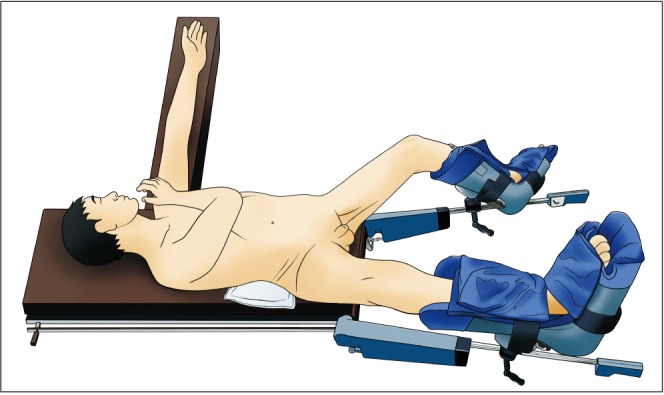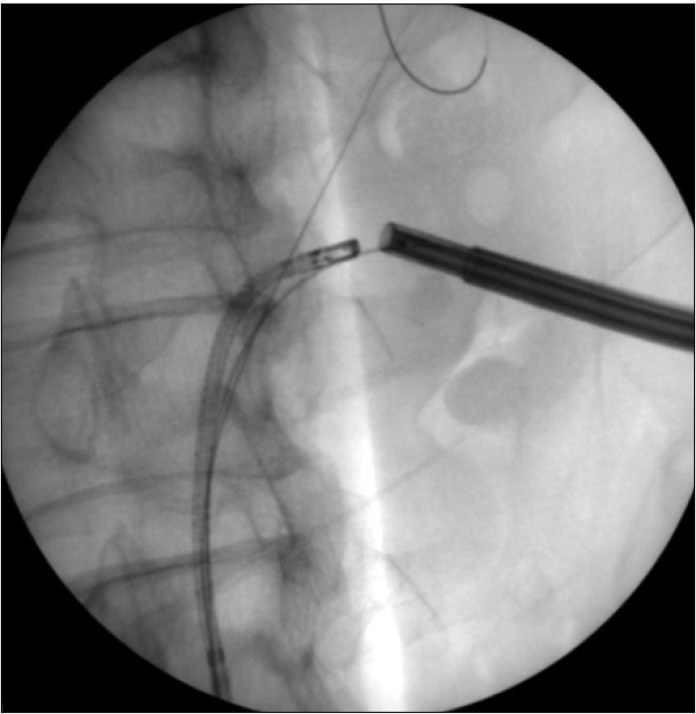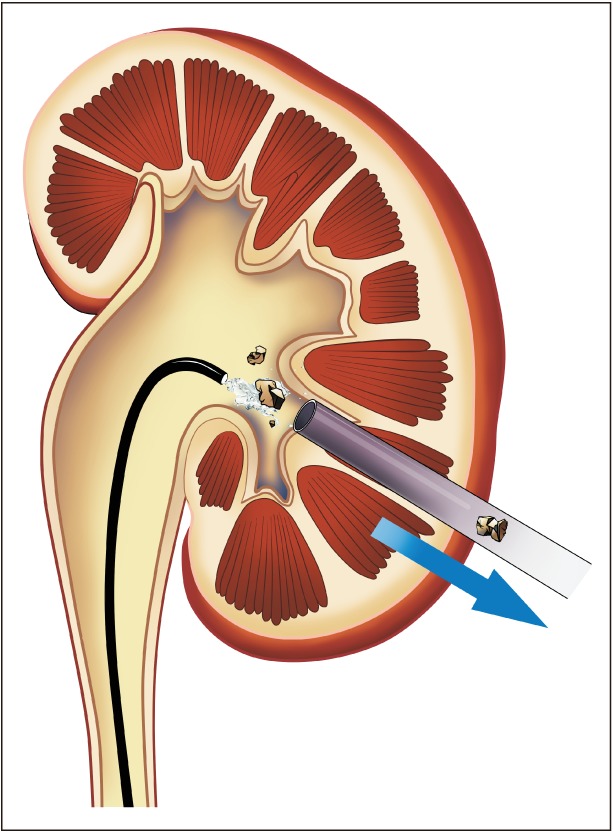Investig Clin Urol.
2018 Sep;59(5):348-354. 10.4111/icu.2018.59.5.348.
Real-time simultaneous endoscopic combined intrarenal surgery with intermediate-supine position: Washout mechanism and transport technique
- Affiliations
-
- 1Department of Urology, Yongin Severance Hospital, Yonsei University Health System, Yongin, Korea. joouro@yuhs.ac
- 2Department of Urology, Severance Hospital, Urological Science Institute, Yonsei University College of Medicine, Seoul, Korea.
- 3Department of Radiology, Severance Hospital, Research Institute of Radiological Science, Yonsei University College of Medicine, Seoul, Korea.
- KMID: 2419419
- DOI: http://doi.org/10.4111/icu.2018.59.5.348
Abstract
- Endoscopic combined intrarenal surgery (ECIRS) with simultaneous retrograde intrarenal surgery (RIRS) and percutaneous nephrolithotomy (PCNL) has been proposed as a new surgical treatment to overcome the disadvantage of RIRS and PCNL monotherapies in the treatment of renal stone. One of advantages of ECIRS is that it can increase stone-free rates in complex renal stone within single-session. Intermediate-supine position in real-time simultaneous ECIRS can prevent an anesthesiologic problem, and patient's burden is small even for long-term operation. Thus, we will share the experience and advantages of real-time simultaneous ECIRS and introduce techniques to increase the stone-free rate.
Keyword
Figure
Cited by 1 articles
-
Recommendations for Antibacterial Prophylaxis in Endourological Procedures
Doo Yong Chung, Joo Yong Lee
Urogenit Tract Infect. 2019;14(1):1-8. doi: 10.14777/uti.2019.14.1.1.
Reference
-
1. Kang DH, Cho KS, Ham WS, Chung DY, Kwon JK, Choi YD, et al. Ureteral stenting can be a negative predictor for successful outcome following shock wave lithotripsy in patients with ureteral stones. Investig Clin Urol. 2016; 57:408–416.
Article2. Kang SK, Cho KS, Kang DH, Jung HD, Kwon JK, Lee JY. Systematic review and meta-analysis to compare success rates of retrograde intrarenal surgery versus percutaneous nephrolithotomy for renal stones >2 cm: an update. Medicine (Baltimore). 2017; 96:e9119. PMID: 29245347.3. Türk C, Petřík A, Sarica K, Seitz C, Skolarikos A, Straub M, et al. EAU Guidelines on Interventional Treatment for Urolithiasis. Eur Urol. 2016; 69:475–482. PMID: 26344917.
Article4. Cho SY. Current status of flexible ureteroscopy in urology. Korean J Urol. 2015; 56:680–688. PMID: 26495068.
Article5. Atis G, Culpan M, Pelit ES, Canakci C, Ulus I, Gunaydin B, et al. Comparison of percutaneous nephrolithotomy and retrograde intrarenal surgery in treating 20–40 mm renal stones. Urol J. 2017; 14:2995–2999. PMID: 28299761.6. Lehman T, Bagley DH. Reverse lithotomy: modified prone position for simultaneous nephroscopic and ureteroscopic procedures in women. Urology. 1988; 32:529–531. PMID: 3201661.
Article7. Marguet CG, Springhart WP, Tan YH, Patel A, Undre S, Albala DM, et al. Simultaneous combined use of flexible ureteroscopy and percutaneous nephrolithotomy to reduce the number of access tracts in the management of complex renal calculi. BJU Int. 2005; 96:1097–1100. PMID: 16225535.
Article8. Scoffone CM, Cracco CM, Cossu M, Grande S, Poggio M, Scarpa RM. Endoscopic combined intrarenal surgery in Galdakao-modified supine Valdivia position: a new standard for percutaneous nephrolithotomy? Eur Urol. 2008; 54:1393–1403. PMID: 18715696.
Article9. Hamamoto S, Yasui T, Okada A, Taguchi K, Kawai N, Ando R, et al. Endoscopic combined intrarenal surgery for large calculi: simultaneous use of flexible ureteroscopy and mini-percutaneous nephrolithotomy overcomes the disadvantageous of percutaneous nephrolithotomy monotherapy. J Endourol. 2014; 28:28–33. PMID: 23987470.
Article10. Jeong CW, Jung JW, Cha WH, Lee BK, Lee S, Jeong SJ, et al. Seoul national university renal stone complexity score for predicting stone-free rate after percutaneous nephrolithotomy. PLoS One. 2013; 8:e65888. PMID: 23824752.
Article11. Jung JW, Lee BK, Park YH, Lee S, Jeong SJ, Lee SE, et al. Modified Seoul national university renal stone complexity score for retrograde intrarenal surgery. Urolithiasis. 2014; 42:335–340. PMID: 24623504.
Article12. Lee JY, Kim JH, Kang DH, Chung DY, Lee DH, Do Jung H, et al. Stone heterogeneity index as the standard deviation of Hounsfield units: a novel predictor for shock-wave lithotripsy outcomes in ureter calculi. Sci Rep. 2016; 6:23988. PMID: 27035621.
Article13. Chung DY, Lee JY, Kim KH, Choi JH, Cho KS. Feasibility and efficacy of intermediate-supine percutaneous nephrolithotomy: initial experience. Chonnam Med J. 2014; 50:52–57. PMID: 25229016.
Article14. Hoznek A, Rode J, Ouzaid I, Faraj B, Kimuli M, de la Taille A, et al. Modified supine percutaneous nephrolithotomy for large kidney and ureteral stones: technique and results. Eur Urol. 2012; 61:164–170. PMID: 21570174.
Article15. Nuño de la Rosa I, Palmero JL, Miralles J, Pastor JC, Benedicto A. A comparative study of percutaneous nephrolithotomy in supine position and endoscopic combined intrarenal surgery with flexible instrument. Actas Urol Esp. 2014; 38:14–20. PMID: 23911215.
Article16. Cracco CM, Scoffone CM. ECIRS (Endoscopic Combined Intrarenal Surgery) in the Galdakao-modified supine Valdivia position: a new life for percutaneous surgery? World J Urol. 2011; 29:821–827. PMID: 22057344.
Article17. Ibarluzea G, Scoffone CM, Cracco CM, Poggio M, Porpiglia F, Terrone C, et al. Supine Valdivia and modified lithotomy position for simultaneous anterograde and retrograde endourological access. BJU Int. 2007; 100:233–236. PMID: 17552975.
Article18. Watterson JD, Soon S, Jana K. Access related complications during percutaneous nephrolithotomy: urology versus radiology at a single academic institution. J Urol. 2006; 176:142–145. PMID: 16753389.
Article19. Usui K, Asai T, Tabei T, Ito H, Komeya M, Fujikawa A, et al. A case of endoscopic combined intrarenal surgery for multiple encrusted stones on a forgotten ureteral stent left for 4 years. Hinyokika Kiyo. 2016; 62:585–589. PMID: 27919137.20. Benincasa A, Nicolosi F, Lughezzani G, Buffi NM, Casale P, Hurle R, et al. Safety and feasibility of salvage endoscopic combined intrarenal surgery in embolized kidney. J Endourol Case Rep. 2016; 2:127–130. PMID: 27579440.
Article21. Auge BK, Dahm P, Wu NZ, Preminger GM. Ureteroscopic management of lower-pole renal calculi: technique of calculus displacement. J Endourol. 2001; 15:835–838. PMID: 11724125.
Article22. Aguiar P, Pérez-Fentes D, Garrido M, García C, Ruibal Á, Cortés J. A method for estimating DMSA SPECT renal function for assessing the effect of percutaneous nephrolithotripsy on the treated pole. Q J Nucl Med Mol Imaging. 2016; 60:154–162. PMID: 27064495.23. Manikandan R, Mittal JK, Dorairajan LN, Mishra AK, Sreerag KS, Verma A. Endoscopic combined intrarenal surgery for simultaneous renal and ureteral stones: a retrospective study. J Endourol. 2016; 30:1056–1061. PMID: 27479769.
Article24. Kwon O, Park J, Cho MC, Son H, Jeong H, Cho SY. Feasibility of single-session endoscopic combined intrarenal surgery for ipsilateral large renal stones and retrograde intrarenal surgery for contralateral renal stones: initial experience. Int J Urol. 2017; 24:377–382. PMID: 28281312.
Article
- Full Text Links
- Actions
-
Cited
- CITED
-
- Close
- Share
- Similar articles
-
- Efficacy and safety of modified tract dilation technique using simultaneous pulling of proximal and distal ends of a guidewire for percutaneous nephrolithotomy in modified supine position
- Retrograde Intramedullary Nailing for Humerus Fracture in a Supine Position: Performing an Unfamiliar Procedure in a Familiar Position
- Spirometry on Supine position in Young Healthy Students
- The Change of Vertical Deviation in the Seated and Supine Position
- The Change of Exodeviation in the Seated and Supine Position




